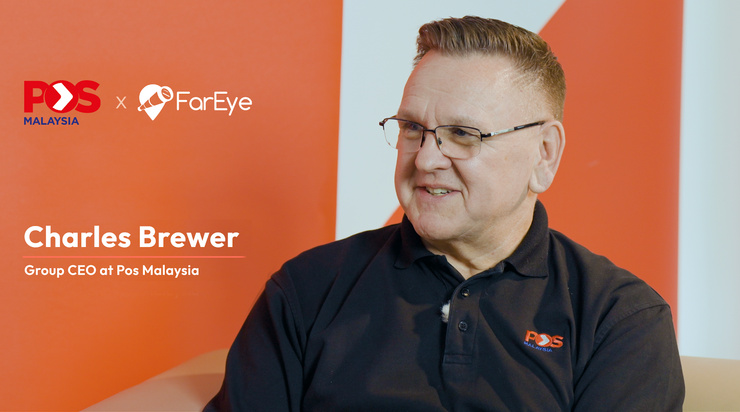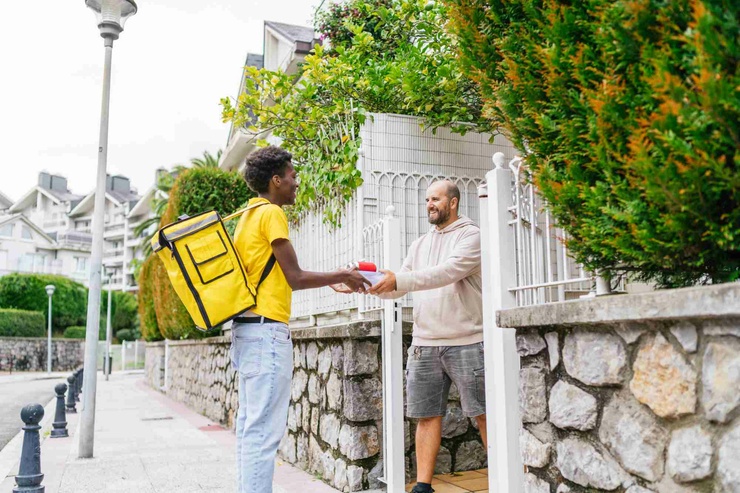- Last-Mile
- Carrier 3PL
- Visibility
What is Last mile carrier tracking? Why is it important?
Table of Contents
- What is last-mile carrier tracking?
- Importance of Last Mile Delivery Tracking
- What is last mile tracking number?
- How to track the last mile carrier?
- Challenges in Last Mile Carrier Tracking
- Solutions for Last Mile Delivery Tracking
- Benefits of Last Mile Tracking
- Final Mile Tracking Technologies
- Use cases
- Conclusion

The modern customer expects their delivery experience to be predictable and wants to track their packages in real-time, especially in the last mile. Anticipation anxiety is a no-go zone and a cardinal sin while designing a delivery experience.
Last-mile carrier tracking is an effective way to keep customers proactively informed of their shipment status. This increases transparency and trust.
For the dispatchers, it brings to their attention the gaps along the delivery route to ensure deliveries are made on time and with minimal cost. By implementing an effective last-mile logistics software tracking system, businesses can reduce costs and ensure customer satisfaction throughout the shipping process.


What is last-mile carrier tracking?
Last mile carrier tracking is a service that allows customers to track the location and status of their package during the last leg of the delivery process, from the distribution center to the final delivery destination, also popularly known as the last-mile.
This provides customers with a host of critical information about the delivery, that include - LIVE ETA visibility, details of the person executing the delivery in the last mile and also allows customers to place special instructions such as ‘leave at the door’, ‘do not ring the bell’, ‘call me’ etc.

Importance of Last Mile Delivery Tracking
- Transparency: By providing updates in real-time on the status of their package, including the location, delivery status monitoring, expected delivery time, and any delays or issues that may arise, businesses can build transparency that helps to build trust and confidence in the brand.
- Customer satisfaction: By mitigating anticipation anxiety with last-mile carrier tracking, customer satisfaction is greatly improved. The ability to place special instructions, further gives customers additional flexibility.
- Reduced failed deliveries: When customers know that they are to expect a delivery within a stipulated timeframe, they are more likely to ensure they are available to receive them. This reduces the chances of delivery success as against a failure due to customer unavailability.
- Reduction of Support costs: WISMO calls contribute to significant overheads by increasing the support costs while also making customers disgruntled. By empowering customers to track the status of their their shipments through carrier tracking, they can significantly reduce costs.


What is last mile tracking number?
A last mile tracking number, also known as a final mile tracking number or delivery confirmation number, is a unique identifier assigned to a package or shipment to track its movement from the transportation hub to the final delivery destination.
The "last mile" in logistics refers to that leg of the delivery process, where the package is transported from a given location - warehouse/local distribution center to the recipient's address. The last mile tracking number is used to monitor the package's progress during this crucial stage, ensuring that it arrives at its destination on time and in good condition.
Typically, last mile tracking numbers are provided by the carrier or shipping company and can be used by the recipient to track the package's status through online portals or mobile apps. The process entails them to visit the URL of the carrier and there is usually a provision to enter this number on their portal. At the back end, a query is run based on the tracking number and in a matter of seconds, the status is displayed on the screen. It could be anything from ‘At the warehouse’ to ‘Out for delivery’. These are typically configurable and in sync with the real-time status of the shipment based on entries received at different stages.
This enables the recipient to stay informed about the estimated delivery time and date and make any necessary arrangements to receive the package.
How to track the last mile carrier?
Tracking a last mile carrier usually involves using the tracking information provided by the shipper, typically the retailer who has sent products that were ordered. Here are the general steps to track a last mile carrier:
- Identify the tracking number: The tracking number is typically provided by the shipping company or the online retailer from whom you made the purchase. If you don't have the tracking number, contact the retailer or shipping company to obtain it.
- Visit the carrier's website: Once you have the tracking number, go to the website (order tracking portal) of the carrier responsible for the final delivery. For example, if you ordered something from Amazon and it is being delivered by USPS, go to the USPS website.
- Enter the tracking number: Look for the option to track a package on the carrier's website and enter the tracking number provided to you.
- Track the package: Once you have entered the tracking number, you should be able to see the current status and location of your package. This may include information about when the package was picked up, when it arrived at the local distribution center, and when it is expected to be delivered to your address.
- Contact carrier: If you have any questions or concerns about the delivery of your package, you can contact the carrier directly using the contact information provided on their website.
Keep in mind that the tracking information may not be updated in real-time and there may be delays or issues outside of the carrier's control. If you have any concerns about the delivery of your package, it is best to contact the carrier directly for more information.

Challenges in Last Mile Carrier Tracking
While last mile delivery tracking can provide numerous benefits, there are also several challenges that need to be addressed. Some of the key challenges in last mile delivery tracking include:
- Lack of precision: Real-time factors such as traffic conditions, route diversions, the impact of bad weather in some instances, are not factored as they happen. This leads to less accurate information getting tracked leading to incorrect expectations of delivery timelines.
- Siloed Systems: Collating information across multiple systems can be a significant challenge.
- Communication lapses: Communication lapses between delivery drivers and dispatchers due to ineffective channels can lead to lapses and delays. If at any point, a status update fails to get registered, it puts the order in a black box. Setting up timely interventions and alerts can mitigate this.
- Technical glitches: Last mile delivery tracking systems can be prone to technical issues, such as network outages or software glitches. These issues can prevent delivery companies from accessing real-time data and can lead to delays or inaccurate delivery estimates.
- Cost: Implementing last mile delivery tracking systems can involve setting up infrastructure that can enable status sharing from time to time. While this has benefits in the long-run, the upfront cost can be a barrier for some companies.
- Customer expectations: Finally, customer expectations can be a challenge in last mile delivery tracking. Customers may expect real-time updates and may be dissatisfied if they do not receive accurate information about their deliveries.


Solutions for Last Mile Delivery Tracking
- GPS tracking: The use of GPS technology can provide real-time delivery tracking of delivery vehicles and packages. This allows delivery companies to monitor their fleet, optimize routes, and provide accurate delivery estimates to customers.
- Mobile applications: Mobile applications can be used to provide drivers with real-time updates on traffic and route changes. This helps them to make adjustments to their routes and schedules, which can improve on-time delivery rates and delivery accuracy.
- Improved communication: Effective communication between drivers and dispatchers is critical for last mile delivery tracking. Delivery companies can invest in technology that provides two-way communication between drivers and dispatchers, such as instant messaging and voice calls.
- Cloud-based software: Cloud-based software can provide delivery companies with a centralized platform with real time tracking dashboards for managing their operations, including last mile delivery tracking. This can help to streamline operations, reduce costs, and improve efficiency.
- Smart lockers: Smart lockers can provide an alternative delivery option for customers who are not available to receive their packages in person. These lockers can be placed in convenient locations and can be accessed using a code or mobile application.
- Blockchain technology: Blockchain technology can be used to provide a secure and transparent platform for last mile delivery tracking. This technology can help to prevent fraud, increase transparency, and reduce the risk of security breaches.
Benefits of Last Mile Tracking
- Reduced anticipation anxiety: Customers typically tend to face anticipation anxiety when expecting deliveries. By providing a real-time tracking, businesses can greatly reduce this anxiety as the customer always gets to know where their orders are at any given point in time,
- Reduced missed deliveries: When customers know when to expect a package through last mile tracking of carriers, there is a higher chance of availability. This reduces the chances of missed deliveries.
- Improved customer experience: Last mile tracking allows customers to track their packages in real-time, providing them with greater visibility and control over their deliveries. This can help to improve customer satisfaction through tracking.
- Increased efficiency: Delivery companies can use last mile tracking for driver route monitoring and automated route updates to optimize their delivery routes and schedules, reducing the time and costs associated with last mile delivery.
- Reduced delivery errors: Last mile tracking can help to reduce the risk of delivery errors, such as missed deliveries or package theft. This can help to improve the overall reliability of the delivery service.
- Improved resource utilization: By tracking their vehicles and packages in real-time, delivery companies can better utilize their resources, such as delivery vehicles and personnel. This can help to reduce costs and improve operational efficiency.
- Enhanced supply chain visibility: Last mile tracking can provide greater visibility and control over the entire supply chain, from the warehouse to the customer. This can help to improve supply chain efficiency and reduce costs.


Final Mile Tracking Technologies
There are several last mile delivery tracking technologies that are commonly used in the industry, including:
- GPS tracking: GPS (Global Positioning System) technology is widely used for tracking delivery vehicles and packages in real-time. GPS tracking allows delivery companies to monitor their vehicles, optimize routes, and provide accurate delivery estimates to customers.
- RFID tags: RFID (Radio Frequency Identification) technology can be used to track packages as they move through the supply chain. RFID tags can be scanned at various checkpoints to provide real-time updates on package location and status.
- Barcodes: Barcodes are widely used for package tracking and can be scanned at various points throughout the delivery process. Barcodes provide real-time updates on package location and status, allowing delivery companies to provide accurate delivery estimates to customers.
- Mobile applications: Mobile applications can be used to provide drivers with real-time updates on traffic and route changes. This helps them to make adjustments to their routes and schedules, which can improve on-time delivery rates.
- Electronic logging devices: Electronic logging devices (ELDs) are used to track the hours of service of commercial drivers. ELDs can help to ensure that drivers are complying with federal regulations and can provide real-time data on driver location and activity.
- Internet of Things (IoT): IoT technology can be used to monitor and track packages using sensors and connected devices. IoT devices can provide real-time data on package location, temperature, and other factors that can impact delivery.
Each technology enhances the accuracy and transparency of carrier performance analytics.
Use cases
Here are some case studies that demonstrate the benefits of final mile delivery tracking:
- Amazon: Amazon is a leading e-commerce retailer that uses advanced last mile delivery tracking technologies to provide real-time updates on package status and location. Amazon has developed its own in-house logistics network, which uses GPS tracking, mobile applications, and other technologies to optimize delivery routes and schedules. By leveraging these technologies, Amazon has been able to improve its delivery times and reduce costs, which has helped the company to remain competitive in the crowded e-commerce space.
- UPS: UPS is a global package delivery and logistics company that has implemented a range of last mile delivery tracking technologies to improve its operations. UPS uses RFID tags to track packages as they move through its logistics network, which provides real-time updates on package location and status. The company also uses GPS tracking and mobile applications to optimize its delivery routes and schedules, which helps to reduce delivery times and improve customer satisfaction.
- Domino's Pizza: Domino's Pizza is a leading pizza delivery chain that has implemented last mile delivery tracking technologies to improve its delivery times and accuracy. Domino's uses GPS tracking and mobile applications to optimize its delivery routes and schedules, which has helped to reduce delivery times and increase customer satisfaction. The company has also developed its own in-house delivery tracking system, which provides real-time updates on package location and status.
- DHL: DHL is a global logistics leader that has implemented last mile delivery tracking technologies to improve its operations. DHL uses a range of technologies, including GPS tracking, mobile applications, and IoT devices, to optimize its delivery routes and schedules. The company has also developed its own in-house logistics platform, which provides real-time updates on package location and status. By leveraging these technologies, DHL has been able to improve its delivery times and reduce costs, which has helped to maintain its competitive edge in the logistics industry.


Conclusion
In conclusion, last mile delivery tracking is a crucial aspect of the logistics industry, as it helps to improve delivery times, increase customer satisfaction, and reduce costs.
By leveraging the latest tracking technologies and management strategies, delivery companies can optimize their operations and provide a better customer delivery experience. While there are challenges associated with last mile delivery tracking, such as the high costs of implementing new technologies and the need to balance accuracy with efficiency, the benefits far outweigh the costs.
Ultimately, the companies that invest in last mile delivery tracking will be best positioned to succeed in the increasingly competitive e-commerce and logistics markets, and to meet the evolving needs of their customers in the years to come.

Komal Puri is a seasoned professional in the logistics and supply chain industry. As the AVP of Marketing and a subject matter expert at FarEye, she has been instrumental in shaping the industry narrative for the past decade. Her expertise and insights have earned her numerous awards and recognition. Komal’s writings reflect her deep understanding of the industry, offering valuable insights and thought leadership.
Let's Talk to Our Experts and Optimize Your Deliveries Today!
An expert from our team will reach out within 24 hours
Related resources


